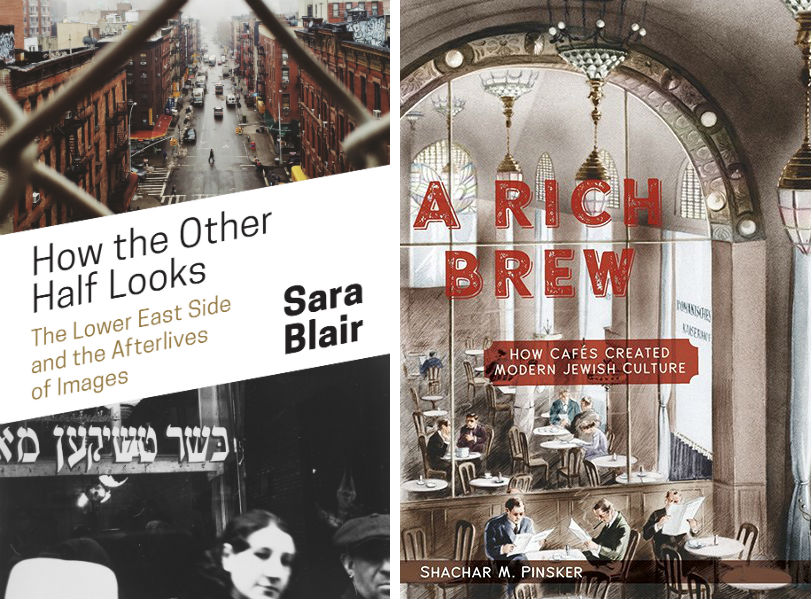Sense of Place: Two books by U-M professors explore Jewish culture, arts, and community

People need a place beyond home and workspace. Community, this sense of “third place” and placemaking, is featured prominently in How the Other Half Looks: The Lower East Side and the Afterlives of Images by Sara Blair and A Rich Brew: How Cafes Created Modern Jewish Culture by Shachar M. Pinsker.
The authors, both professors at the University of Michigan, say that their books began at the Frankel Institute for Judaic Studies. Both were part of a fellowship named Jews in the City, which brought together scholars from a variety of disciplines and led to publications about topics such as Tel Aviv’s Old Cemetery, the Jewish Ghetto of Turin, and the Soviet Shtetl.
Blair says her focus on the Lower East Side (LES) of New York City “began as an attempt to answer a difficult question: What would it mean to write a site-specific history of visual representation and practices? The Lower East Side seemed (forgive the pun) tailor-made for that project.” While Pinsker did not initially think he would write a book about the topic, he quickly began receiving responses to an article he published about the influence of cafes on Jewish writers and thinkers. “People shared with me stories, materials, images, and it showed me how much interest there is in the topic. People often told me that reading my writing, they were nostalgic for places they’ve never been to. I felt the same. I also made sure to visit all the cities I wrote about and get to know very well the places. Although these coffeehouses don't exist anymore, I found it incredible to visit the traces of these places, and work in the archives to find textual and visual materials about them.”
Blair’s How the Other Half Looks explores the LES as a place where creativity and invention burst forth from the people who lived in this part of New York. As these image-makers lived with the energy and density of so many people around them, they invented and tested new visual forms that reflected their daily lives and interactions with their fellow citizens. This led to the creation of revolutionary poetry, new forms of cinema, and the birth of America photojournalism. A key focus of the book is what it means to become an American by tracing “a set of images and ideas -- an iconography -- of the LES that moves across genres, visual and narrative forms, and very different cultural contexts. Complex associations with vice, poverty, raw energy, the threat of the alien and the unassimilated, have continued to swirl around New York’s historical ghetto through its many lives and afterlives, well into our own moment.”
Rich Brew examines six cities whose cafes nurtured the exchange of ideas and political ideologies that helped form the pillar of Jewish culture. Pinsker explores how the coffeehouses served as a nexus for the Jewish writers, thinkers, and artists, all of whom were first or second-generation immigrants. The author says his book was inspired by “a realization that urban cafés had a crucial role of as meeting grounds for Jewish writers and thinkers in the modern period of transnational migration from 1848-1939, and in the decades following World War II. ... My research on Hebrew and Jewish modernism led to time and again to the space of the cafe,” which was not traditionally considered a Jewish space but rather was viewed as background to cultural artistry. Pinsker “decided to put the space of the coffeehouse at the center of my inquiry and use it as a lens understand the history of modern Jewish culture.”
The authors intend for these books to appeal to a wider audience beyond academia. Pinsker says that they can be read by “anyone who has interest in urban space, migration, modern culture, literature, photography, art, Jewish history, European, American, and Middle Eastern literature, and other important topics that are vital and relevant to understand the world we live in.”
Blair agrees on the wide appeal of the subjects. “I also hope that my readers are as amazed as I've been by the range of projects that were shaped by an encounter with the Lower East Side, from the emergence of photography as an art form and the rise of the U.S. film industry to efforts to revive print culture in digital contexts. On all these and more, the Lower East Side has left its own indelible mark. And that’s the story I aim to tell.”
Patti F. Smith is a special education teacher and writer who lives in Ann Arbor with her husband.
Shachar Pinsker and Sara Blair will read from their books at 7 pm on Wednesday, October 10 at Literati.


































